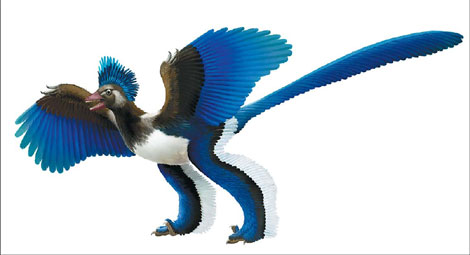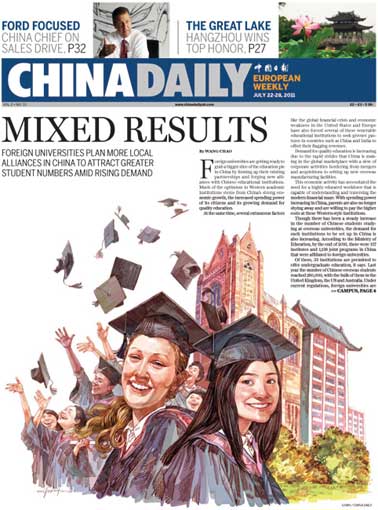Heritage
Archaeopteryx knocked off its perch
Updated: 2011-07-29 08:01
(China Daily)
|
A handout illustration shows an artist's impression of Xiaotingia zhengi, a previously unknown species of bird-like dinosaur from the Late Jurassic in China. AFP / Nature |
New findings by Professor Xu Xing, with the Institute of Vertebrate Paleontology and Paleoanthropology, suggest it was just another dinosaur, not the father of birds.
The winged archaeopteryx, long thought to be the distant ancestor of birds, was knocked off its evolutionary perch in a study published on Wednesday. A new dinosaur species unearthed in Jianchang county, Liaoning province, suggests the 150-million-year-old "original bird" is probably just another dinosaur with feathers, of which there are many.
Since its discovery 150 years ago in Bavaria, most scientists have placed archaeopteryx at the root of the broad group of proto-birds, known as Avialae, from which our modern feathered friends emerged.
The archaeopteryx has been used since as a case study of evolution, in this case, from dinosaur to bird.
Over the years, a few scientists have gingerly expressed doubts, pointing to supposedly defining bird-like characteristics - feathers, the wishbone, three-fingered hands - that were also showing up in non-avian dinosaurs.
By examining the fossil of a new species named Xiaotingia zhengi, an archaeopteryx-like theropod dinosaur, the skeptics have finally found evidence to support their doubts.
In the research paper published online in the journal Nature, a team led by Professor Xu Xing, with the Institute of Vertebrate Paleontology and Paleoanthropology (IVPP) under the Chinese Academy of Sciences, concluded the new dinosaur species that was found in rock formations formed about 160 million years ago, is more closely related to velociraptors, as in the Jurassic Park films, rather than birds.
Xiaotingia weighed about 800 grams, comparable to archaeopteryx, and is one of the smallest non-avian theropod (carnivorous) dinosaurs ever identified by scientists. It has conical teeth, as well as long, robust arms that are similar to those of primitive birds. Its specialized feet have the highly extensible second toe characteristic of the Deinonychosauria, the group of bird-like dinosaurs that includes velociraptor.
"The most exciting result from our research is that both xiaotingia and archaeopteryx are primitive deinonychosaurs rather than birds. In other words, archaeopteryx is a kind of velociraptor ancestor rather than a bird ancestor," says Xu, who has discovered more than 40 dinosaur species - more than any other living scientist.
Surprised by their findings, Xu and his team ran the analysis again, but this time without the newly discovered species. Archaeopteryx was restored - in error, they now knew - to its previous perch as a bird ancestor.
Xu has called for further confirmation, but suggests his discovery will overturn long-held assumptions about the "avian ancestral condition".
"Perhaps the time has come to finally accept that archaeopteryx was just another small, feathered, bird-like theropod fluttering around in the Jurassic," Lawrence Witmer, a professor at Ohio university's Heritage College of Osteopathic Medicine, comments in Nature.
One of the most important jobs now is to reconstruct a reliable family tree for birds and dinosaurs and Xu's team has made several significant discoveries related to this issue.
The researchers noticed that, xiaotingia, and anchiornis are more similar to other deinonychosaurs than to birds, in having a lightly built skull, in stark contrast to the more robust skull seen in other known primitive birds and also the Oviraptorosaurian, a group of feathered Maniraptoran dinosaurs from the Cretaceous Period of what is now Asia and North America.
A comprehensive analysis by the researchers indicates an evolutionary divergence between a primarily herbivorous lineage leading to modern birds and a carnivorous lineage leading to velociraptor. This new pattern has significant implications for avian origins, and for related issues such as the early evolution of feathers and flight.
Xu suggests that feather evolution may have started in a common ancestor of pterodactyls and dinosaurs - nearly 240 million years ago, or some 95 million years before archaeopteryx.
In 2008, Xu and his team discovered a new feathered four-winged dinosaur named Anchiornis huxleyi in honor of the English biologist Thomas Henry Huxley, who first raised the idea in 1870 that birds - the most diverse group of land vertebrates, with nearly 10,000 living species - descended directly from dinosaurs.
"At that time we already noticed some striking similarities between anchiornis and archaeopteryx, such as the presence of a long bony tail fully covered by large feathers," the paleontologist says.
"Xiaotingia was excavated from the same formation as anchiornis. Like anchiornis, it also bears long flight feathers on the feet, a feature we suspected was also present in archaeopteryx. The discovery of xiaotingia provides further support for a close relationship between these species."
The new dinosaur, xiaotingia, is named in honor of Zheng Xiaoting, to recognize his efforts in establishing the Shandong Tianyu Museum of Nature, as a repository for vertebrate fossils from China. In particular, more than 1,000 skeletons of feathered dinosaurs are housed at this museum, constituting a resource with great potential for research on dinosaur evolution.
China Daily / AFP
E-paper

Ringing success
Domestic firms make hay as shopping spree by middle class consumers keeps cash registers ringing in Nanjing
Mixed Results
Crowning achievement
Living happily ever after
Specials

Ciao, Yao
Yao Ming announced his retirement from basketball, staging an emotional end to a glorious career.

Going the distance
British fitness coach comes to terms with tragedy through life changes

Turning up the heat
Traditional Chinese medicine using moxa, or mugwort herb, is once again becoming fashionable

